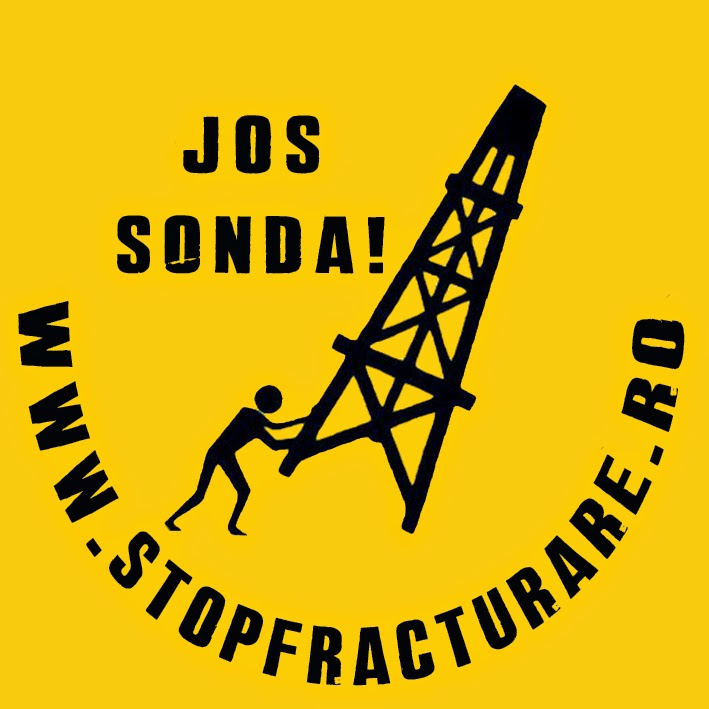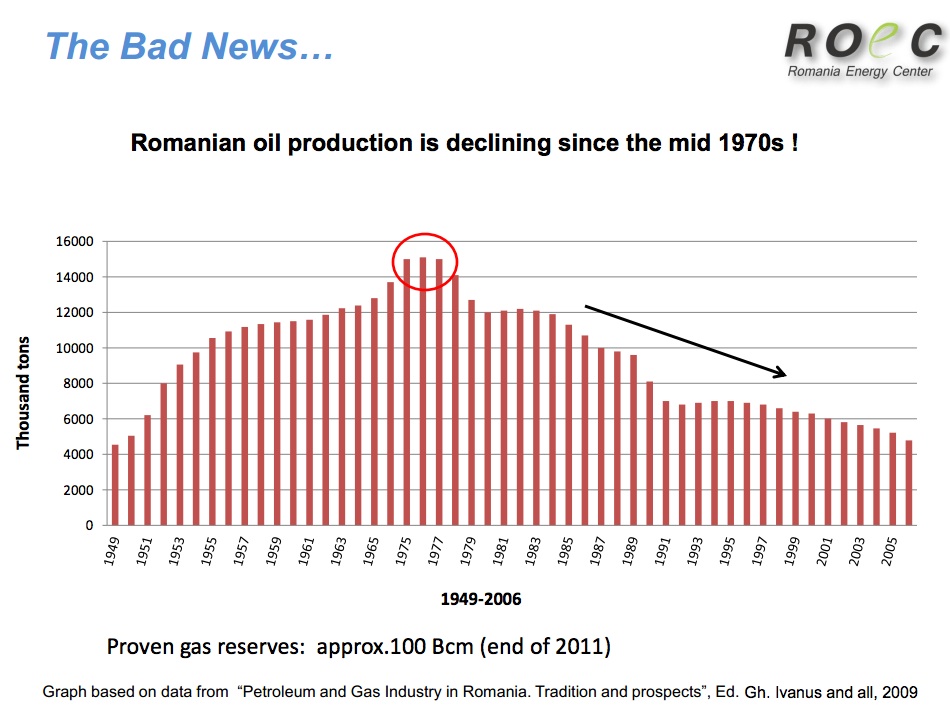Fracking for natural gas (gazelor de sist) is apparently coming back to Romania. During 2013 and 2014, Chevron started exploratory fracking operations in the region of Romania known as Moldova, while facing down intense anti-fracking protests. After several months during which Chevron managed to start drilling, completed an exploratory well, taking samples, the company eventually pulled out of Romania under suspicion the exploratory well may have come up dry.
Today, Romanian news website Ziare.com![]() , the Christian Science Monitor
, the Christian Science Monitor![]() , WorldOil.com
, WorldOil.com![]() , and is reporting the Romanian government plans to hold a meeting in March 2016 on the role Romania plays in regional natural gas and oil supply. The Romania Oil & Gas Summit (ROGS) will take place on March 16-17 2016, in Bucharest, and is being organized by Romania’s Ministry of Energy. (www.rog-summit.com)
, and is reporting the Romanian government plans to hold a meeting in March 2016 on the role Romania plays in regional natural gas and oil supply. The Romania Oil & Gas Summit (ROGS) will take place on March 16-17 2016, in Bucharest, and is being organized by Romania’s Ministry of Energy. (www.rog-summit.com)
The agenda listed on the website focuses on Romania as “a pillar of European energy” and includes these topics:
- Offshore Black Sea – deep and shallow water exploration potential
- Romania’s pipeline interconnectivity with neighbouring TSOs
- Prospects for refined products
- Romania as a potential net exporter of gas?
- Stimulating investment and insuring security of energy supply
Let’s tease this apart a bit to understand what’s being said. The reporting on Ziare.com and the CSM both suggest this conference will be about bringing Fracking back to Romania, but the ROG-Summit website doesn’t explicitly say so.
The statement “Romania as a potential net exporter of gas?” is curious because Romania’s existing natural gas supply situation is a little precarious. While Romania is much less dependent on Russian natural gas than its neighbors, its domestic natural gas production has been falling for years.
As I noted last year, some in Romania’s fossil fuel industry make the case that Romania must frack itself or face a grim prospect of being dependent on others for fossil fuels. That’s because of falling conventional oil and natural gas production in Romania.
Romania as a net exporter of natural gas had been the goal of bringing in Chevron and other fracking companies. According to geological estimates, the country has large frackable shale deposits. Since the rest of Europe has little or no domestic fossil fuel supplies, it was hoped that Romania’s shale could help avert European dependence on Russian natural gas.
Recent Natural Gas news in Romania
In Aug 2015, Ziare.com published a report![]() suggesting falling oil and gas prices might make it less likely any company will want to develop offshore oil in the Black Sea.
suggesting falling oil and gas prices might make it less likely any company will want to develop offshore oil in the Black Sea.
There are frequent news reports discussing a proposed natural gas pipeline between Romania and Moldova which is to begin construction in 2016. That pipeline should help the process of reuniting these two countries. They’d been split asunder before World War II when Russia grabbed that territory, and geopolitics have kept them apart ever since.
Earlier this week hotnews.ro carried a piece![]() saying Hungarian oil company MOL received approval for oil exploration in two new blocks of Romanian territory. The agreement between Agentia Nationala pentru Resurse Minerale (ANRM) (National Agency for Mineral Resources) and MOL Hungarian Oil covered an area known as EX-5 ADEA. MOL has existing agreements for other blocks dating back to 2012.
saying Hungarian oil company MOL received approval for oil exploration in two new blocks of Romanian territory. The agreement between Agentia Nationala pentru Resurse Minerale (ANRM) (National Agency for Mineral Resources) and MOL Hungarian Oil covered an area known as EX-5 ADEA. MOL has existing agreements for other blocks dating back to 2012.
The current status is MOL is seeking approval from locals to begin drilling. This is a shale formation, and therefore will require fracking.
Yesterday, Lukoil, PanAtlantic, and Romgaz announced discovery of a large deepwater natural gas field![]() off Romania’s shore in the Black Sea. Lukoil’s share is 72%, PanAtlantic’s is 18%, and Romgaz’s is 10%. Seismic data indicated that the gas field’s area can reach up to 39 square km and that natural gas reserves could exceed 30Bcm. Further drilling will take place next year to confirm the find.
off Romania’s shore in the Black Sea. Lukoil’s share is 72%, PanAtlantic’s is 18%, and Romgaz’s is 10%. Seismic data indicated that the gas field’s area can reach up to 39 square km and that natural gas reserves could exceed 30Bcm. Further drilling will take place next year to confirm the find.
Today, a report in the Azerbaijan’s press![]() talks of a natural gas “transmission corridor” starting in Azerbaijan. The Azerbaijan-Georgia-Romania Interconnector (AGRI) for liquefied natural gas is expected to transport liquefied Azeri gas from Georgia, across the Black Sea, to a LNG terminal to be built on the Romanian Black Sea Coast. From that point, the gas will be pumped through Romanian natural gas transmission system to Hungary, through the Interconnector between Romania and Hungary (Arad – Szeghed) to be transported further to the European market.
talks of a natural gas “transmission corridor” starting in Azerbaijan. The Azerbaijan-Georgia-Romania Interconnector (AGRI) for liquefied natural gas is expected to transport liquefied Azeri gas from Georgia, across the Black Sea, to a LNG terminal to be built on the Romanian Black Sea Coast. From that point, the gas will be pumped through Romanian natural gas transmission system to Hungary, through the Interconnector between Romania and Hungary (Arad – Szeghed) to be transported further to the European market.
A month ago another report in Azerbaijan’s press![]() discussed talks with Turkmenistan for a natural gas transportation corridor. The route would liquefy natural gas in Turkmenbashi, ship it across the Caspian sea to Baku (Azerbaijan), then by railway to Batumi or Poti (Georgia, the Black Sea region), and then by sea to Constanta on Romania’s Black Sea coast.
discussed talks with Turkmenistan for a natural gas transportation corridor. The route would liquefy natural gas in Turkmenbashi, ship it across the Caspian sea to Baku (Azerbaijan), then by railway to Batumi or Poti (Georgia, the Black Sea region), and then by sea to Constanta on Romania’s Black Sea coast.
A couple weeks ago, Reuters reported that Romgaz has no interest in fracking any shale deposits![]() , at least for a few years. Instead the company will keep on with conventional natural gas resources.
, at least for a few years. Instead the company will keep on with conventional natural gas resources.
“We always stressed our base activity is conventional exploration, there are many things to do here, on the other hand as a perspective, it would be good to find out (the country’s) non-conventional potential,” Romgaz’s General Director, Virgil Metea, told the Reuters East European Investment Summit. However, Metea did limit that comment to the next five years or so, leaving the door open to fracking sometime in the future.
Summary
In short, Romania is positioning itself as not only a domestic producer of natural gas and oil, but a major transshipment point for natural gas from Central Asia. It’s not entirely clear when or if fracking will actually return to Romania.
- The USA should delete Musk from power, Instead of deleting whole agencies as he demands - February 14, 2025
- Elon Musk, fiduciary duties, his six companies PLUS his political activities - February 10, 2025
- Is there enough Grid Capacity for Hydrogen Fuel Cell or Battery Electric cars? - April 23, 2023
- Is Tesla finagling to grab federal NEVI dollars for Supercharger network? - November 15, 2022
- Tesla announces the North American Charging Standard charging connector - November 11, 2022
- Lightning Motorcycles adopts Silicon battery, 5 minute charge time gives 135 miles range - November 9, 2022
- Tesla Autopilot under US Dept of Transportation scrutiny - June 13, 2022
- Spectacular CNG bus fire misrepresented as EV bus fire - April 21, 2022
- Moldova, Ukraine, Georgia, Russia, and the European Energy Crisis - December 21, 2021
- Li-Bridge leading the USA across lithium battery chasm - October 29, 2021










